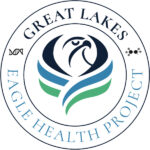Per- and polyfluoroalkyl substances (PFAS) are a family of over 5,000 chemicals that can be found in a variety of consumer and industrial products such as nonstick cookware, water‐repellent and stain‐repellent formulations, fire‐fighting foams, pesticides, surfactants, etc. PFAS can be found in groundwater, surface water, soil, air, plants, animals and humans. These chemicals can have negative ecological and human health impacts, such as impacts on the endocrine system, immune system, reproductive system and have been linked to some cancers. Although this family of chemicals has been around since the 1940s, there is limited knowledge about environmental contamination of PFAS, exposure pathways of PFAS, wastes, biosolids and remediation of PFAS, PFAS toxicology and epidemiology and more. Our goal is to determine the knowledge gaps in PFAS research while developing and fostering collaborations between academic staff and governmental agencies.
Projects:
Great Lakes Eagle Health Project
 The Great Lakes Bald Eagle Health Project has tracked reproduction success and contaminant levels in eagles across Wisconsin since 1990, with an emphasis on eagles nesting along the Great Lakes shorelines. A team of state, federal, and academic researchers are studying how contamination influences eagle health, which can also tell us how pollution impacts ecosystems and people.
The Great Lakes Bald Eagle Health Project has tracked reproduction success and contaminant levels in eagles across Wisconsin since 1990, with an emphasis on eagles nesting along the Great Lakes shorelines. A team of state, federal, and academic researchers are studying how contamination influences eagle health, which can also tell us how pollution impacts ecosystems and people.
PFAS Bioaccumulation in Fish
PFAS have been detected in environments throughout Wisconsin including soil and multiple lake ecosystems. These PFAS chemicals have been shown to accumulate in different animal species including fish. Our goals are to understand (i) what lakes contain PFAS and contain fish with elevated levels of PFAS, (ii) how PFAS is bioaccumulating in different fish species and where in the fish, (iii) how early life stages of fish are impacted by PFAS-contaminated waters and (iv) how communities of color and low income are disproportionally impacted by PFAS fish consumption guidelines.2021 PFAS Workshop: Setting a research agenda for PFAS in Wisconsin
Workshop White Paper PDF
Hazard Index
PFAS are commonly found in the environment as a mixture of multiple different chemicals and different PFAS can have the same health effects on ecological and human health. People can be exposed to PFAS through a variety of different exposure pathways including drinking water.
Wisconsin Sea Grant has partnered with the Wisconsin Department of Health Services to create different communication resources and tools to understand PFAS exposure.



